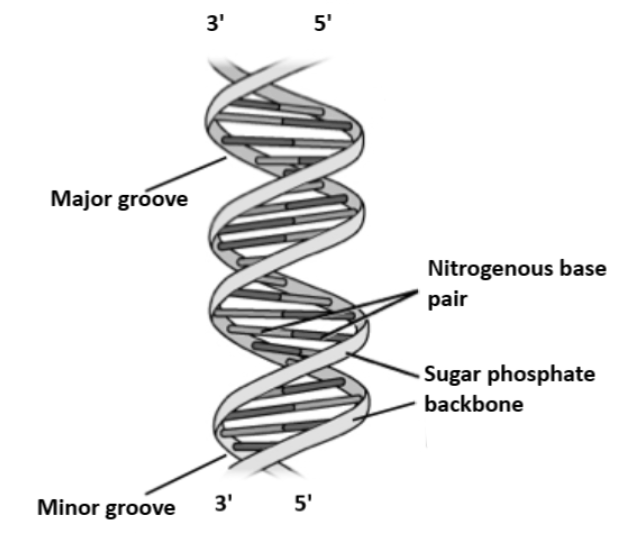
Describe Watson and Crick model of DNA.
Answer
481.5k+ views
Hint: A double-stranded, antiparallel, right-handed helix is the structure of DNA, as represented in the model of Watson and Crick. The DNA strands' sugar-phosphate backbones make up the outside of the helix. On the inside, the nitrogenous bases are established and form hydrogen-bonded pairs that keep together the DNA strands.
Complete answer:
• DNA stands for Deoxyribonucleic acid, a molecule containing the instructions required to grow, live and reproduce an organism.
• It is a form of nucleic acid and is one of the four main types of macromolecules considered to be important to all life forms.
• DNA's three-dimensional structure, first suggested in
• Two polymer strands coiled around each other are used in each DNA molecule.
• Each strand has a
• The strands are antiparallel, meaning one strand runs in a direction from
• The diameter of the double helix is

Note: If an A on one strand is detected, it must be combined with a T on the other (and vice versa). Similarly, for a partner on the opposite strand, a G located on one strand must always have a C. These associations of A-T and G-C are known as complementary base pairs. Since a large purine (A or G) is often combined with a small pyrimidine (T or C), the helix's diameter is uniform, reaching approximately
Complete answer:
• DNA stands for Deoxyribonucleic acid, a molecule containing the instructions required to grow, live and reproduce an organism.
• It is a form of nucleic acid and is one of the four main types of macromolecules considered to be important to all life forms.
• DNA's three-dimensional structure, first suggested in
• Two polymer strands coiled around each other are used in each DNA molecule.
• Each strand has a
• The strands are antiparallel, meaning one strand runs in a direction from
• The diameter of the double helix is

Note: If an A on one strand is detected, it must be combined with a T on the other (and vice versa). Similarly, for a partner on the opposite strand, a G located on one strand must always have a C. These associations of A-T and G-C are known as complementary base pairs. Since a large purine (A or G) is often combined with a small pyrimidine (T or C), the helix's diameter is uniform, reaching approximately
Recently Updated Pages
Master Class 12 Business Studies: Engaging Questions & Answers for Success

Master Class 12 English: Engaging Questions & Answers for Success

Master Class 12 Social Science: Engaging Questions & Answers for Success

Master Class 12 Chemistry: Engaging Questions & Answers for Success

Class 12 Question and Answer - Your Ultimate Solutions Guide

Master Class 11 Economics: Engaging Questions & Answers for Success

Trending doubts
Draw a labelled sketch of the human eye class 12 physics CBSE

a Tabulate the differences in the characteristics of class 12 chemistry CBSE

Which one of the following is a true fish A Jellyfish class 12 biology CBSE

Why is the cell called the structural and functional class 12 biology CBSE

Differentiate between homogeneous and heterogeneous class 12 chemistry CBSE

Write the difference between solid liquid and gas class 12 chemistry CBSE




